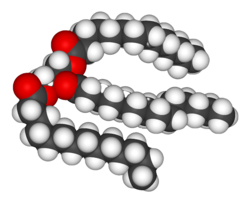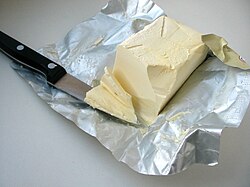Fat

Fat is one of the three main types of macronutrients.[1] Fats are found in many foods. They are made of macromolecules called lipids. Lipids are based on long-chain fatty acids. Some of these are essential because the body cannot make them.
Types and functions
There are three different types of fats: Unsaturated fats, Saturated fats, and Trans fats.[2]
Unsaturated fats
Unsaturated fats are liquid at room temperature. They are considered useful fats because they can improve blood cholesterol levels, and ease heart rhythms. Most vegetable oils are liquid at room temperature and have unsaturated fats. There are two kinds of unsaturated fats, Mono-unsaturated fats, and polyunsaturated fats.[3] It is commonly found in avocados, nuts, peanuts, seeds, wild fish, and olive oil. For polyunsaturated fats, it is recommended to have an omega-3 to omega-6 ratio of 1:1.[4][5]

Saturated fats
Saturated fats will likely have no benefits. They are mainly found in animal foods, but a few plant foods are also high in saturated fats. Too much saturated fat in your diet can lead to heart disease and other health problems, such as gaining weight or increasing the risk of heart disease or stroke. People should not eat too much saturated fats. You should limit saturated fat to less than 10% of your daily calories.[6] It can usually be found in dairy products, meat products, and grain-based desserts.
Trans fats
Trans fatty acids are commonly called trans fats. They are a kind of unsaturated fat. Trans fats may be natural or they may be made.[7] Naturally-occurring trans fats are found in the guts of some animals and foods which are made from these animals. Artificial trans fats are made in an industrial process. The process adds hydrogen to liquid vegetable oils to make them more solid. Trans fats are worse for cholesterol levels than saturated fats. They are most likely found in frying, baked goods, and processed foods.
Roles
Good roles
Fats are used to absorb or get nutrients, like Fat-soluble Vitamins for humans. They are used as a source of backup energy in cases when carbohydrates are not available, or people can not use it at that time. People need more than 20 to 35% of daily calories from fat. Also, fats play a role in helping people's body maintain or keep the core (center) temperature.[8] However, too much fat or the wrong kinds are also harmful, in other words, fats can have bad effects on human's bodies.
Good fats & bad fats
Bad fats, in other words, trans fats, have no known health benefits and will damage someone's heart and take them away from healthy. People might get diseases like blindness, which means they can not see anything because of having too much cholesterol and other fats. Most of the foods that contain these types of fats are solid at room temperature, such as butter and animal meat. On the other hand, good fats are naturally found in foods and will not damage the human's organs. The example foods of good fats are avocados, eggs, and nuts.
Important types
Unsaturated fatty acids are very important. They are called by where their double bond is placed. Omega-3 fatty acids (ω-3) and omega-6 fatty acids (ω-6) are essential: you need them both. They help build longer molecules which do cell signaling in different tissues. There are over 20 different signaling paths that control a wide array of bodily functions.
Eat fat and burn fat
Why do you need to eat fat to burn fat?
Medium-chain triglycerides are good for burning fat. They are easily absorbed, digested, and reused as energy. Eating milk fat, palm oil, and coconut oil will burn fat because they contain medium-chain triglycerides.[9]

Fat can be important for people, but too much fat is bad. The fat we eat can provide energy for us. Not all fatty foods are good for you, such as pizza, french fries, and hamburgers. The fat from those may cause you become fatter, and your health may become terrible.[10]
Diet
Fats also provide long-term energy for humans and, in cold climates, a layer of insulation to keep the body warm. They help the body use the vitamins found in foods. Fats are also good for the skin and hair. Olive oil is an especially healthy fat. Many types of fish also contain healthy fat, for example salmon, sardines, herring, and tuna. But if too much fat collects in the body, a person can become too heavy. The energy given by fats is used by moving around or exercising. Some vegetables like celery or carrots contribute much less to the bodies fat supply. Though being very important for the human body, it can also be harmful in large amounts.
Health risks
Too much fat (especially Trans fats) in the body can cause diseases. Indeed, obesity, meaning too much fat, is sometimes called a disease itself. One disease from excess fat is called "fatty liver". It is a condition which can be resolved by eating different foods. Fatty liver is when someone has too many fats in their liver, but it can also be associated by alcohol or metabolic syndrome. Fatty liver can be fixed by exercise and better diet. This is one of the hidden danger of fats.
Another hidden danger of fats is that it can cause some heart diseases. One example is Heart Failure. Heart Failure is an illness that does not have enough heart pumps blood. It lowers the leading of blood flow.
The main ways to avoid these issues are exercise and good eating. Exercise reduces excess body fat and strengthens the body. Healthy diet keeps nutritious balance in your body and helps remove the fats in your body.
Fat Media
Idealized representation of a molecule of a typical triglyceride, the main type of fat. Note the three fatty acid chains attached to the central glycerol portion of the molecule.
Example of an unsaturated fat triglyceride. Left part: glycerol, right part from top to bottom: palmitic acid, oleic acid, alpha-linolenic acid. Chemical formula: C55H98O6
Margarine is a common product that can contain trans fats.
Cover of the original Crisco cookbook, 1912. Crisco was made by hydrogenating cottonseed oil. The formula was revised in the 2000s and now has only a small amount of trans fat.
Reference ranges for blood tests, showing usual ranges for triglycerides (increasing with age) in orange at right
References
- ↑ The others are proteins and carbohydrates.
- ↑ "Types of Fat". Harvard T.H. Chan School of Public Health. 9 June 2014. Retrieved 16 May 2016.
- ↑ "Types of Fats". Medline Plus - Trusted Health Information for You. Retrieved 1 June 2016.
- ↑ Simopoulos, A. P. (October 2002). "The importance of the ratio of omega-6/omega-3 essential fatty acids". Biomedicine & Pharmacotherapy = Biomedecine & Pharmacotherapie. 56 (8): 365–379. doi:10.1016/s0753-3322(02)00253-6. ISSN 0753-3322. PMID 12442909.
- ↑ MacIver, Melissa (2019-04-30). "Omega-3:Omega-6, What's the best ratio?". Carolina Sports Clinic. Retrieved 2021-05-07.
- ↑ "Facts about saturated fats". Medline Plus - Trusted Health Information for You. Retrieved 20 May 2016.
- ↑ "Trans fat". American Heart Association. Retrieved 19 May 2016.
- ↑ Melodie Anne (December 12, 2018). "Three Functions of Fat in the Body". SFGATE. Archived from the original on June 5, 2016.
- ↑ "Medium-Chain Triglycerides". galegroup.com. Retrieved 25 May 2016.
- ↑ "Why You Eat Fat to Burn Fat". Lives Strong.com. Retrieved 25 May 2016.








